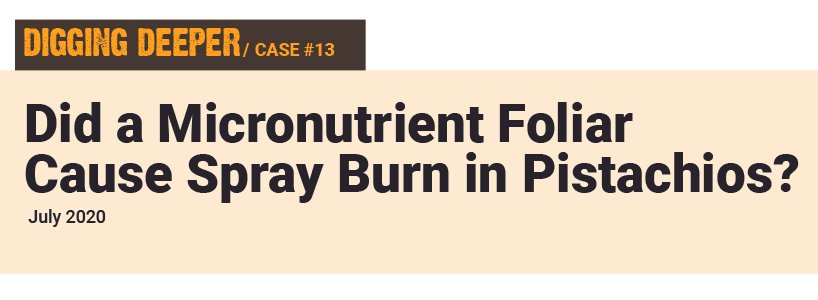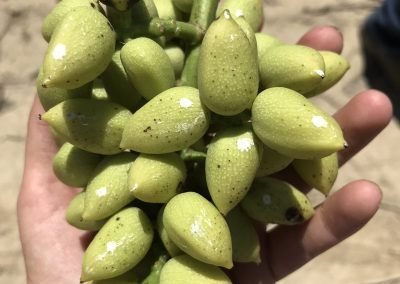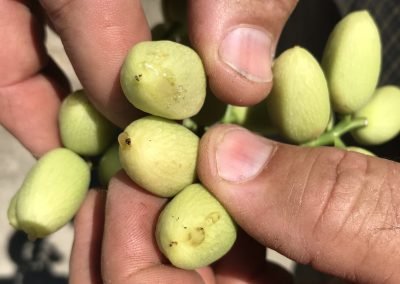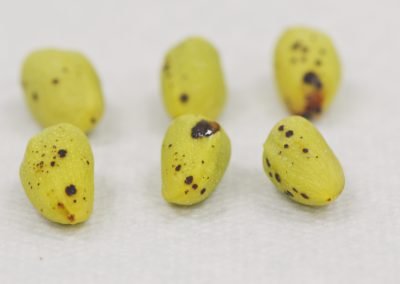
HEre’s what the scene looks like:
SYMPTOMS:
- Black necrotic spotting on hulls, primarily at tips but also on top and sides of nuts. Damage ranged from tiny spots to severe necrosis affecting up to half the hull.
- No identifiable pattern within the field, tree or bunch. On some trees only a single bunch was affected, or a single nut within a bunch.
- Large spots of white residue on some bunches, identified to be from a recent micronutrient spray with wettable sulfur. The pattern of white residue spots did not appear to correlate to the black spots.
- Black spots initially thought to increase toward one edge of the field near a large dairy, but the spots were different and eventually identified to be fly frass (unrelated).
- Some weeping on nuts was observed, but did not appear to be related to the black spotting symptoms.
FIELD INFO:
- Variety: Golden Hills pistachios
- Location – Kern County, CA
- Drip irrigation
- Stage of growth: nut fill, typical crop load
- Nearby ranches of Golden Hills variety (incl. some from other farming companies) that showed similar symptoms were NOT sprayed with the foliar spray.
- Other varieties on the ranch that received the foliar spray (Lost Hills & Kerman) did NOT have the symptoms.
- Most recent fertilizer application was a micronutrient-based foliar spray that included some wettable sulfur. Spray was applied 5 days before grower informed us of issue.
- There was a missed pesticide application that likely resulted in the weeping symptoms.
Here’s what WE KNOW ABOUT SPRAY BURN AND PISTACHIOS:
- “Spray burn” is a generalization for burn-like symptoms on leaves and/or fruit that can be attributed to one of two causes. Both types of spray burn can have similar visual symptoms.
- pH burn: Lowering the pH of a spray can increase the rate at which the plant absorbs the nutrients in the spray. If the plant is not able to disperse the high concentration of the nutrients, it can result in spray burn symptoms.
- Severe nutrient toxicity: When too much of a nutrient is applied to plant tissue, the plant cannot disperse the nutrient and symptoms such as edge necrosis, discoloration, etc. may result (symptoms vary based on the nutrient and crop).
- The pattern of spray burn symptoms is typically irregular within the plant and on the leaves/fruit. Generally speaking within the field there is no identifiable pattern; however, near the ends of the rows it is common to see higher concentrations of the burn symptoms. This is because the plants near the ends of the rows commonly get sprayed with extra materials as spray equipment tend to slow down at row ends.
- Pistachios are not known to be exceptionally sensitive to nutrient toxicities.
- Pistachios are not known to be sensitive to foliar spray pH when compared to other nut crops.
CONNECTING THE DOTS
- Although the symptoms may be similar to those from spray burn, the pattern of symptoms did not match the spray application. Many trees that got the application showed no symptoms, and trees that were not sprayed did show symptoms. Rather than following a pattern of the spray application, the pattern followed the Golden Hills variety. So we ruled out a nutrient or pH spray burn.
- With some research, several articles were found that provide another explanation for the symptoms. These conditions are related to low calcium in the plant during cell division of the nut.
- “PEL” is a condition that produces symptoms in pistachios similar to the symptoms observed in this case. It is a somewhat rare condition, but the research was done prior to the Golden Hills variety going into production. Article – PEL in Pistachios
- “Stylar end lesion” is a condition similar to blossom end rot in tomatoes and produces symptoms that are similar to those observed in this case Article – Stylar End Lesion
- Calcium is primarily absorbed through the roots, and therefore requires that the plant is transpiring (drinking) for calcium to be absorbed. A calcium deficiency can be caused by various things, including:
- Lack of availability
- Nutrient antagonism (excessive N, K and Mg)
- Low transpiration due to cold, wet temperatures or soil (Earlier developing varieties are more susceptible to calcium deficiency because they go through the stage of cell division during cooler, wetter times of the year.)
- Fruit is particularly susceptible to calcium deficiency symptoms because calcium transport is driven by respiration (plant tissues giving off water into the air), and the respiration rate of fruit is lower than that of the leaves.
- Calcium plays a key role in cell wall formation. If sufficient calcium is unavailable during cell division, the quality of the fruit may be compromised, resulting in damaged tissue as the fruit matures.
- An XRF analysis confirmed that the most affected tissues were low in Ca, suggesting that during nut development there was a lack of available calcium likely brought on by wet, cold soil conditions in the early spring and possible nutrient competition/antagonism
CASE WRAP-UP
The symptoms in this case were clearly not due to spray burn. The sample data showing a calcium deficiency in the damaged portion of the nut, along with the articles on stylar end lesion and PEL make a strong case that the symptoms are related to a calcium deficiency. Because the Golden Hills variety is an early-developing variety, it is more susceptible to calcium deficiency during cell division caused by cold, damp conditions of early spring. Nutrient antagonisms were not an obvious factor but may have played a minor role.
***
Thank you Kaitlyn Garcia from Tulare Ag Products for letting us dig deeper with you on this case!














